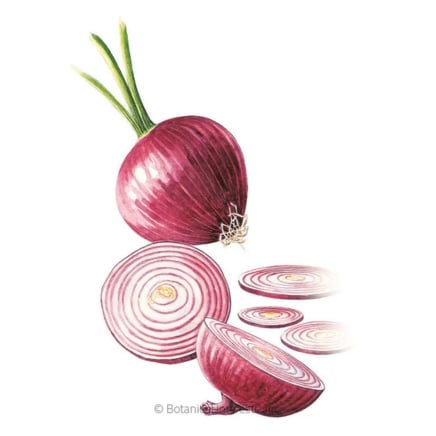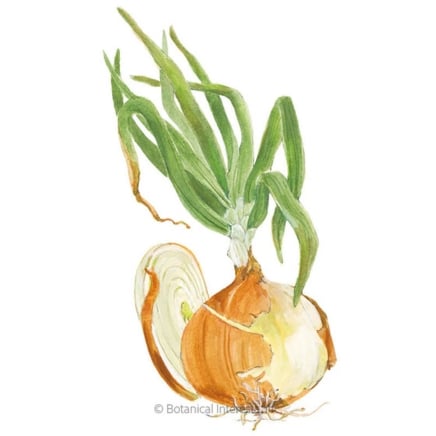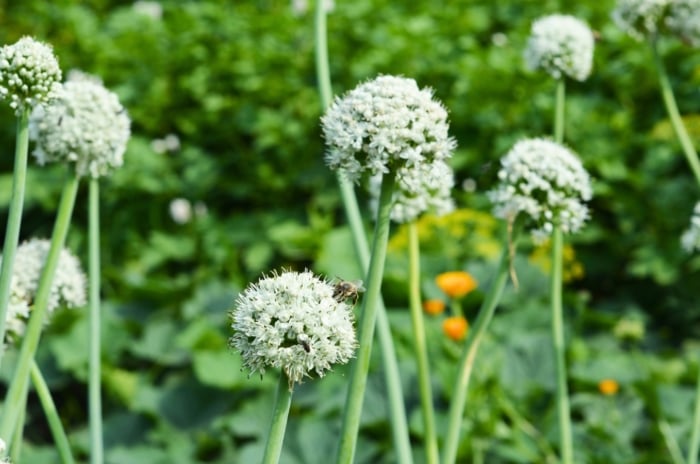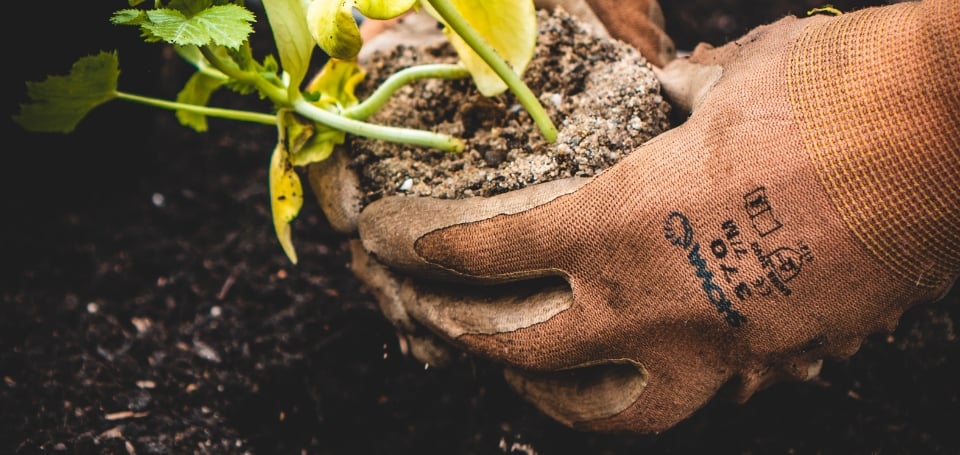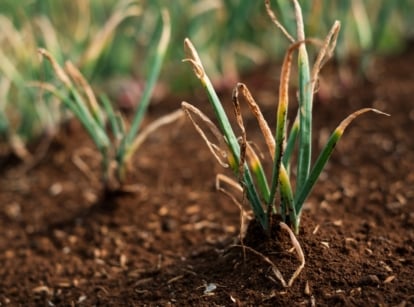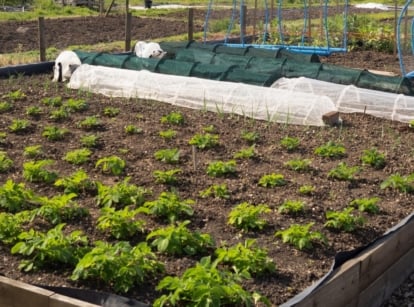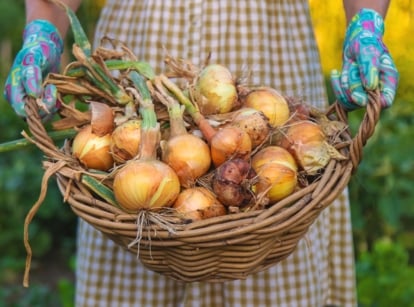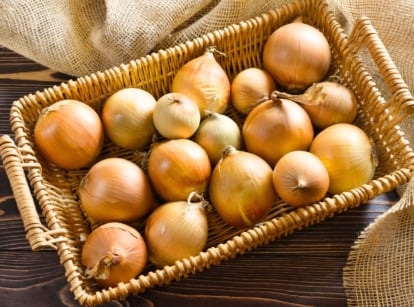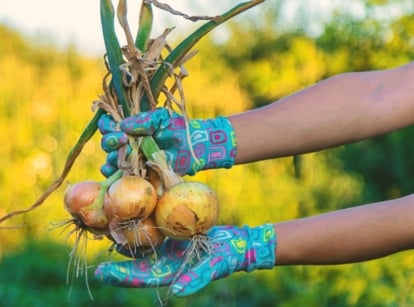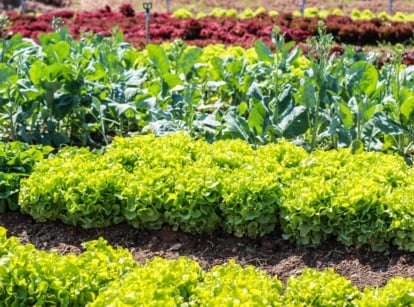7 Causes of Rotting, Mushy Onions from the Garden
Onions are earthy, spicy bulbs that are usually easy to grow and mostly problem-free. But the large rounds sometimes experience underground issues or problems in storage that leave them less than desirable. Gardening expert Katherine Rowe explores causes of rotting onions and how best to prevent them.

Contents
Whether red, white, or sweet, big rounds, onions are the ultimate in versatile flavor. Bright, spicy, and pungent when fresh, they mellow during cooking to sweeten the pot with caramelized earthy notes.
Just as the flavor profiles, colors, and forms differ, so does a key growing requirement: day length hours. The first step in choosing the best onion for your climate is picking a variety with a corresponding amount of day length as it relates to latitude. Some onions require 10 to 12 daylight hours (good for the south and warmer climates), while others need as many as 16 (a fit for more northerly gardens).
With the right variety of Allium cepa in hand, it’s time to wait for the sets, seeds, or transplants to mature over a few months. If all goes well, the root vegetables fully develop into a multitude of firm, juicy rounds. With inconsistencies in cultural requirements, though, the bulbs may slip into a “rotten to the core” funk.
We’ll explore common reasons why onions rot or become mushy in the ground and why they can spoil quickly during storage. Corrections for the next round of growing, including crop rotation, can help yield a healthy harvest.
Yellow Sweet Spanish Utah Bulb
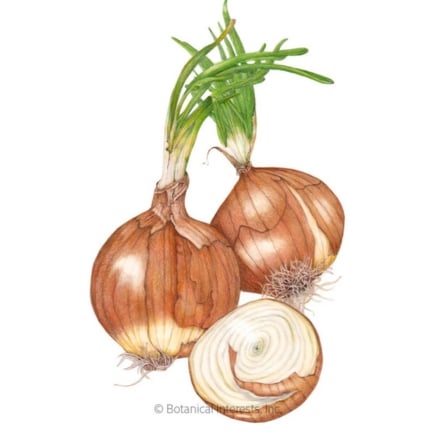
Yellow Sweet Spanish Utah Bulb Onion Seeds
Growing Notes

Onions are unfussy root vegetables, but they’re long-maturing, taking as many as 130 days to develop. With the large bulbs of common onions developing underground, they’re susceptible to conditions and variables that we may not be aware of until they present with a rotting, mushy interior.
We touched on day length essentials when honing in on the right variety of bulbing onion for your growing area. Long day onions need 14 to 16 hours, intermediate day 12 to 14, and short day relies on 10 to 12 hours of sunlight. Long days are best above the 37th parallel, short days in southern climates below the 35th, and intermediate everywhere in between. Storage time varies by variety, with some long-maturing, long daylength types ideal for months of storing. Others, like sweet onions, are tender and best enjoyed closer to harvest time.
Optimal growing conditions for the large rounds include:
- Light, organic, well-draining soil
- Slightly acidic to neutral soils with a pH near 6.0 to 6.8
- Cool conditions in spring, fall, or winter (55-65°F or 13-18°C are ideal growing temperatures; they withstand cold better than heat)
- Consistent moisture with about one inch of water per week (rainfall and irrigation)
Overwatering

Regular, even moisture promotes the best bulb development. Fluctuations in water cause stress, and growth slows as a means of conserving energy. Yield, size, and flavor quality may decrease with exposure to dry spells or watering lapses.
About one inch of water per week for evenly moist soils is usually sufficient, with more required closer to harvest time. Stop watering at harvest time when the leafy tops flop over.
When aiming for even moisture, it’s easy to inadvertently overwater. Overly saturated soils are a common cause of onion bulbs rotting. As the bulbs sit in soggy situations, they’re unable to function normally. The excess leads to fungal problems like bulb rot, including several pathogens that affect the genus.
Poor Drainage and Heavy Soils

To avoid wet soils, good drainage is essential for the roots. Onions do best in organically rich, loose soils. Light, sandy loams let the rounds develop easily and unimpeded for a uniform shape.
In dense textures like clay or in compacted soils, the bulbs struggle to create growing space and may become stunted as they seek nutrients and water. If the heavy soils hold water, the fungal issues set in for a mushy Allium.
Work several inches of completely broken-down plant material (compost or leaf mold) into the composition to improve texture, aeration, moisture retention, drainage, and nutrition. Onions are shallow-rooted, but ensure soil and compost amendments are free of debris, clumps, and rocks. The rounds change shape or suffer damage as they bump into impediments underground.
Fertilizer Issues

Onions are heavy feeders, especially initially as leaves and roots develop. The bulbs are extensions of the leaves, which set later. To support leaf and root development, a boost in nitrogen and phosphorus is beneficial. Apply an organic, balanced fertilizer like a 10-10-10 for a nutritive foundation. Sidedress with another application several weeks after planting, at a few inches away from the base of the leaves.
When the “neck” at the base of the stems starts to broaden and displace soil, bulbing begins. Stop fertilizing at this point to avoid excessive nitrogen for leafy growth during production. Excess nitrogen also increases susceptibility to pests and diseases. A soil test is always a good idea to determine what nutrients, if any, are necessary prior to planting.
Overcrowding

The hearty vegetables grow well in containers and raised beds, in addition to in-ground beds. Proper spacing is important for the best yield and crisp, uniform texture. Whether growing from seed, sets, or transplants, cramped conditions can cause deformities. From seed, thin seedlings to six to eight inches apart when they reach two inches tall.
A six-inch spacing allows ample air circulation, reducing the likelihood of fungal diseases from damp and crowded leaves, bulbs, and roots. By not planting too densely, competition for water, nutrients, and sunlight decreases. Fully developed onions without weakness and disease susceptibility form as a result.
Warm, humid conditions are another contributor to ripe fungal conditions, leading to mushy, rotten onions when they lack airflow. Grow the crop in the cooler months in hot climates (fall or winter), and avoid overwatering to minimize prolonged moisture. Keep the bed weed-free, since the slender tops don’t compete well as other vegetation encroaches (and they host pests and diseases).
Diseases
Caused by cultural imbalances or wounds during cultivation that allow a point of entry, fungal and bacterial diseases are a primary cause of rotting, mushy onions. Unfortunately, alliums are subject to a number of pathogens that cause distress and eventually render bulbs unusable. Choosing disease-resistant varieties, balancing care requirements, and knowing what to look for limits the spread.
Center Rot

Center rot is a bacterial disease caused by several pathogens that affects both the leaves and the fruits. Damage can occur in the ground and post-harvest in storage. It presents as water-soaked lesions on stems, which spread to cause wilt and dieback. It creeps toward the neck of the onion and spreads to the inner scales of the bulb, where they become soft, mushy, and rotten. Outer scales may look normal, as only a few interior ones are usually affected.
Hot, humid situations contribute to the spread of center rot. Thrips are vectors for the disease, spreading it from infected plants to healthy specimens as they feed. Rain and irrigation can splash the spores from the soil and surrounding plants onto leaves.
To prevent center rot, avoid wetting the leaves unnecessarily during irrigation. Practice crop rotation, avoiding planting Allium in the same location for two years or more. Horticultural soaps and oils can help control thrip outbreaks if severe.
Fusarium Basal Rot

Several species of the soil-borne fungus Fusarium are responsible for a rot that happens at the bulb level. It presents with leaf tips turning yellow and dying back, while underground, the roots decay, and the bulb gains a white mold and softens first at the base and spreads upward.
Fusarium basal rot often goes undetected, as leaf symptoms correspond to their decline at maturity, when it’s time to harvest. High soil temperatures close to harvest time also accelerate the rot.
Well-drained soils or growing in raised beds help prevent saturated soils. Source high-quality seeds and sets for planting, avoiding any that show shriveling or damage. Crop rotation helps reduce the harboring of spores from season to season.
Purple Blotch

The fungus Alternaria porri mainly affects leaves and stems but can cause onion bulbs to decay and rot, becoming especially mushy around the neck. It begins with watery and yellow spots with rings that turn deep red-purple or black as it progresses. As bulb tissue decays from the neck in storage or from wounds during harvesting, it becomes dry and papery.
Wet conditions, especially in spring, promote purple blotch. The proper cultural conditions are the best prevention, including good air circulation and well-draining soils. Yellow cooking/storage onions show better resistance than sweeter varieties. Avoid weakness caused by overfertilizing, and keep weeds at bay to reduce transmission and overwintering.
Onion Bulb Maggot

These specialized maggots feed on bulbs in the Allium genus and bore into stems, causing them to yellow and wilt. The adults are flies that lay eggs at the base of the stems. The larvae enter the leaves to feed on the stalks, bulbs, and roots. They wound the bulbs, creating an opportunity for Fusarium and other problems to proliferate in the field or in storage.
With bulb maggot outbreaks, plants stunt and wilt. Leaves turn yellow and easily separate from the neck with a pull.
As with diseases, avoid planting onions where you’ve grown alliums like garlic in the last few years. Crop rotation prevents infestations. If maggots are an issue in your area, floating row covers in spring can prevent egg-laying by adult female flies. Planting faster-maturing varieties in late spring helps miss peak larval activity.
Curing and Storage Issues

Sometimes, a healthy-looking onion takes a quick turn for the worse during storage. This is likely due to wounds during harvesting that create openings for fungal problems like botrytis to take hold.
The harvest is at its largest and with the longest storage life when the leafy tops fall over and turn yellow and brown. Carefully pull or lift them, tops and all, with a garden fork, harvesting in the morning, and letting them dry outside for a few days under straw or a layer of onion tops.
Cure them by drying them in a warm, dry space with good air circulation for three to seven days (a shed or garage works well). Some take a longer time to cure, up to two to three weeks. Necks will be completely dry and outer skins papery when curing is complete.
Once cured, clip the roots to ¼ inch and the tops to one inch. Improper prep and curing can lead to decay during storage, even for those with a long shelf life. If you accidentally puncture or nick a bulb during lifting, plan to use it right away rather than storing it.
Store onions in a container with airflow, like a mesh bag, crate, or basket. Ideal storage temperatures are above freezing at 45-55°F (7-13°C) with a relative humidity of 60-70%. The length of freshness is variety dependent, from a few weeks to several months.

